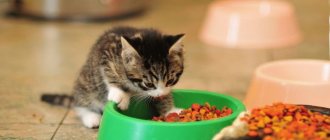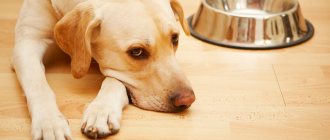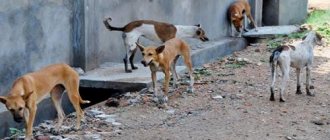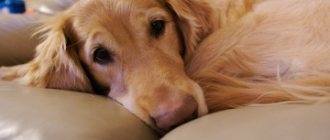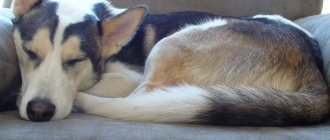List of reasons why a dog refuses food
Unfortunately, animals do not have a second signaling system (a type of nervous activity associated with speech) and cannot communicate their desires and taste preferences. A person can only guess by watching a dog - what it likes and what it doesn’t.
When compiling a diet for an animal, the owner must initially be guided by the usefulness of the food for the dog’s body, then by taste preferences. But this doesn't always happen. Many factors influence the choice and the dog’s opinion is never taken into account.
However, there comes a time when the animal tries with all its might to “express” its opinion. Refusal to feed is his opinion and it has its place, it must be taken into account and an attempt should be made to “resolve”.
There may be several reasons for refusing dry food:
- smell. This is the very first thing that becomes an impulse to eat.
- taste. Hardness and inappropriate size for the dog breed;
- lack of water (when feeding dry food, water must always be freely available);
- problems in the oral cavity and health.
The dog does not eat dry food after switching from natural food
Before transferring a dog from natural feeding to dry food, a test feeding is carried out. This should be done gradually, offering the dog “crackers” as a treat and observing carefully.
It is not a fact that even a hungry dog will immediately start eating dry food, but a constant offer can encourage eating. Food should be offered in small doses and when the dog is hungry. If the first attempt is unsuccessful, you should change the brand of food and try again.
There is a category of dogs that will not eat dry food under any circumstances, and this should be tolerated (the owner is so lucky).
Transfer to dry food
A pet from a breeder will usually already be eating certain kibble. Therefore, there should be no problems with it.
However, it happens that a puppy has been accustomed to dry food since childhood, but now refuses it. This may be due to stress due to the move. Breeders advise not to change the dog’s diet during the first weeks until he adapts to the new conditions.
But it often happens that a dog appears in the house unexpectedly. A small lump brought from the street “just to spend the night”, in most cases, remains in the apartment forever. Having become accustomed to completely different food, such a puppy refuses to eat dry food. What to do in this situation?
You definitely can’t suddenly switch your dog to a new type of diet - the process should be smooth.
You need to gradually add dry food to your usual food over 7-8 days according to the following scheme: on the first day, mix regular food with crackers in a ratio of 1/7, on the second day - 2/7, and so on, until after a week in a plate There won't be any leftover granules.
However, here it is necessary to show firmness and rigidity. If a dog refuses to eat dry food and continues to look tenderly into its eyes, begging for a treat, then it is important not to succumb to provocations. When she gets hungry, she will eat everything in the bowl. If you regularly slip your dog “sweets,” then the transition to another diet may take a long time. In addition, it is important to understand that mixed food is dangerous for your pet’s health.
The pet refuses the usual dry food
If food is purchased in large quantities (even a bag), it is possible that the food has undergone chemical transformations during storage. The fats (and they are quite fatty) have oxidized, become rancid, and the food no longer gives the dog any pleasure. In addition, such food can also be quite harmful.
The second option is that the usual way is to make a defect, not to put in, for example, the right fragrance and the dog will smell it.
In both the first and second cases, you should feed the dog natural food; if it eats, it’s the food.
Advice! You cannot scold or punish your pet for not wanting to eat - everything has its own reasons and they should be identified.
The dog only eats soaked food
Many owners, when accustoming their dog to dry food, begin by soaking the food. In this case, the solvent is chosen not only in the form of water, but also:
- milk;
- kefir;
- bouillon;
- yogurt.
Naturally, such a “filling” is tasty and the dog then simply waits for the “correctly” served dish.
To wean it off, you should offer dry food even when the dog is very hungry. As a last resort, you can pour the “gravy” only a few drops at a time, and eventually abandon it altogether.
After offering dry food to your dog and not seeing any desire to sit down, remove the bowl. The next meal is only after 12 hours. If the animal is examining the food intake area in search of food, you can offer it earlier and observe the reaction. Praise your dog when eating.
How to train a dog to eat what you give
If the dog does not touch the food, there is no need to persuade it. Wait a few minutes and silently remove the bowl until the next feeding. To a caring owner, this measure will seem cruel, but without it it is difficult to achieve a positive result.
- Be patient and do not give your pet absolutely anything until the next scheduled feeding. The break between meals for adult dogs should be at least 10-12 hours, and for puppies - 4-8 hours.
- If the dog does not completely refuse food, but does not finish it completely, at the next feeding, reduce the portion by exactly as much as he did not eat the previous time.
- Now he eats every crumb? Try adding a little bit (but within the daily allowance specified by the manufacturer).
A dog is a smart animal. With this approach, she quickly realizes that the era of food abundance is over, and begins to eat more willingly. And don’t be afraid that your pet will become emaciated and get sick. In nature, predators do not eat every day and feel great. No healthy dog will starve if it is offered nutritious food twice a day.
Features of feeding pregnant dogs
Pregnancy is a physiological process and normally proceeds without complications.
Some owners begin to switch the animal to pregnancy food immediately after mating. This is not worth doing. During the first 1-3 weeks, the embryos and fruits are too small and do not need extra calories.
Next, you should gradually, in portions, add dry food for pregnant women to your regular diet. By the 4th week the transition should be completely completed. During this period, you should carefully monitor the act of defecation.
It should be:
- regular;
- well formed;
- without the stench not typical of a dog.
The dose of food is prescribed individually by each manufacturer, depending on the weight of the dog. This rule should be followed impeccably. It is possible that the dog will need a little more food or less, it all depends on mobility, physical activity, and temperament.
If the animal, at some stage, refuses food, you should not sound the alarm, you need to wait (1-2 doses). In case of prolonged refusal, offer natural food and observe. Perhaps after a while everything will return to normal eating.
By the 4th week, the daily amount of feed will be slightly larger. In order for reception and absorption to take place optimally, it is better to increase the frequency of feeding to 3-4, and before childbirth even up to 5 times.
When choosing dry food for a pregnant dog, you should carefully study the recipe and choose one that has meat and meat products in the first place, and not cereals.
During pregnancy, experienced dog breeders add natural protein products to dry food:
- meat and offal;
- eggs;
- fermented milk products (cheese, yogurt, kefir).
Varied feeding has a more balanced and positive effect on the development of the fetus and the condition of the mother.
Before giving birth, the female may stop eating. This could be in 1-2 days, or maybe in 1-2 hours. There is no need to sound the alarm. During this period, you need to ensure the constant availability of clean water. At the end of the birth process, appetite will return to normal.
How much should a puppy eat per day?
A dog's feeding schedule is usually strict, but can vary depending on the breed and the diet chosen. In any case, the younger the puppy, the more often he is fed.
- Pets from 1 to 2 months old should receive food six times a day.
- Puppies from 2 to 3 months – five times a day.
- Animals that are already 4 months old can be fed four times a day.
- Pets from six months are gradually transferred to an adult diet. At first, food is offered three times, after 8 months - twice a day.
Overfeeding syndrome is a tight belly like a ball. This situation should not be allowed to happen.
Age-related changes
With age, aging (for a dog this is 7+), the animal becomes less energetic and active. Long walks and training are tiring. Sometimes the dog refuses to follow commands and is reluctant to go for a walk. All this is a normal physiological process.
If the amount of dry food is not reduced (with a decrease in physical activity), excess calories will be deposited in the fat depot and the animal will not voluntarily gain weight. This should not be allowed.
With age-related changes, preference is given to special foods that contain less energy. Proteins should predominate in the food, rather than fats and carbohydrates.
In the recipe, meat should come first, and carbohydrate grains should occupy no more than 15%.
If a dog refuses to consume dry food, it can be smoothly transferred to natural feeding.
Stress and life changes
Moving to a new place of residence, the appearance of another animal or a new person in the house, a change in diet - all this is a lot of stress for the dog, and it may refuse its usual food. A responsible owner should be patient and try to pay more attention to his ward if the puppy stops eating dry food. What to do if a hunger strike is associated with a change in residence?
You need to be patient a little, the kids quickly get used to the environment. But it is important to introduce the puppy to new family members and explain the rules of behavior with them: the kitten must obey humans and not offend animals.
Reducing your walking time can also lead to loss of appetite. The dog spends less energy and, accordingly, the amount of the required portion is reduced.
A much bigger problem for him is a sudden transition to a new type of food. Therefore, even changing one brand of food to another can cause protest. As mentioned above, in order for the process not to be painful, it must be done gradually.
It can be difficult to buy expensive industrial food instead of cheap food. Economy food contains a large number of flavoring additives, which can cause addiction in the dog.
Probably the most severe stress for a puppy is separation from its mother and a change of owner. And if in the latter case the little ones quickly come to their senses with due attention, then in the second situation they can become sad for a long time. The stage of getting used to a new person can take a long time and require significant effort. It all depends on the age of the baby. Puppies 1-3 months old begin to accept their owner after a few days, teenagers 6-9 months old can mope for a long time and even refuse their favorite food. The owner must be patient, show the dog that it is loved and will not be abandoned again, and devote a lot of time and effort to it.
Health problems
Refusal from dry food can be associated with various pathological processes in the body.
If a dog approaches the bowl and attempts to eat, but after holding it in the mouth, throws it away, you should examine the mucous membrane and teeth. This reaction may indicate that the animal is developing:
- stomatitis;
- periodontal disease;
- periodontitis;
- caries;
- chipped tooth or tooth loss.
If a problem exists, then in this case the dog will refuse not only dry food, but also refuse to eat food at all. However, she can eat soft food, ground minced meat, cheese curds, and liquid fermented milk products.
For pathologies in the oral cavity, it is practiced to soak dry food in water, milk or broth. Not all dogs will agree to this food, but you should try it.
If the pathology is associated with the esophagus, then the animals will begin to eat the food, but after the first portions they will move away from the bowl. In this case, you should immediately contact a specialist. If this is not possible, offer a raw egg or liquid minced meat with an egg.
In case of pathologies in the body, you should pay attention not only to food intake, but also to watering. High water consumption, or too little, may indicate pathological processes.
When refusing food, pay attention to:
- temperature indicators;
- quality and quantity of fecal matter;
- vomiting and the urge to vomit;
- rapid breathing and lethargy.
You cannot force feed your dog. Establishing a diagnosis and quality therapy will help solve the problem.
Sometimes food causes allergies. However, the owner does not suspect this, since the signs are erased (and the doctor may not see it). The dog consciously refuses food in this case and this must be taken into account. There's a reason for everything.
Diseases and illnesses
The reasons stated above can be classified as subjective. That is, the owner simply thinks that the puppy does not eat dry food well, but in fact the pet receives the nutrients necessary for growth and development.
Objective reasons for poor appetite in a puppy include, as a rule, various health problems. In this case, other symptoms are added to poor appetite:
- lethargy, apathy,
- desire to find a secluded place,
- digestive disorders,
- temperature rise and others.
If you notice these warning signs, it is best to contact your veterinarian immediately.
Poor quality feed
The owner cannot assess the quality of food by smell (meat and bone meal is not pleasant to many, unlike animals), but the dog can. If the food is from the same company, most likely the owner will be able to understand that the smell is significantly different and assume it has spoiled. In this case, you can offer food from another company;
Taking it into the mouth, the dog may feel a bitter, sour, cloying taste, as well as an unpleasant aftertaste, and this factor will influence eating.
You need to take a closer look at the four-legged one. If he takes it and then throws it out of his mouth, then it’s a matter of taste - you need to change the food.
The dog cannot determine that the food consists of grain nutrients and fats of vegetable origin (and the laboratory is not always strong). Unfortunately, no one says that such food is not of high quality. The truth is that they are not intended for the carnivore, whose diet should be dominated by meat components. The amount of preservatives in the feed is so large that it is more harmful than beneficial for the animal.
If the recipe lists grains (especially corn) in the first place, they cannot be called high-quality, although they are often produced by promoted brands (the work of marketers) and the food belongs to the premium and super-premium classes. Dry food is easy to adulterate and not easy to prove.
Feed selection
Breeders, when giving away a tailed friend, almost always accustom him to a certain type of diet and recommend sticking to it.
However, it happens that new owners decide to switch the dog to a new food. This may be due to various factors, including health, the inability to purchase a familiar product, or the fact that the puppy has stopped eating dry food, which he used to chew on both cheeks.
How to choose high-quality “drying”? Of course, it would be a good idea to consult with breeders. Knowing the characteristics of the breed and heredity, they can suggest the best option for suitable food.
If the puppy is taken from the street, then the veterinarian will give such recommendations, based on the age and health of the baby.
But they all agree on one thing - the food must be super-premium or holistic. This food contains a large amount of meat, grains, vitamins and minerals necessary for a dog to live a full life. Unlike cheap food, it does not contain flavoring or aromatic additives. This food also satisfies hunger much better than the economy options, and thanks to this it is consumed much more slowly.
You can’t ignore your baby’s taste preferences. If he doesn’t respect veal, then he’ll turn his nose up at pellets based on it.
Errors in feeding and maintenance
Unfortunately, the owner often thinks more about his own convenience than about his four-legged friend. Of course, it’s easy to buy a bag of food and give it to your dog, a little at a time. Particularly advanced ones install special feeders with dispensers that give out the norm. But is it really that good?
Prices for dry food sometimes play a determining role in the choice. In case of inability to pay, the owner chooses from the cheap segment and does not do the right thing (although expensive feed sometimes consists of soy and corn).
Whatever the rules of feeding and maintenance, everyone is free to adjust them to suit themselves and their dog. The mistake is that people often forget that dogs are carnivores. She does not need grains, porridges, preservatives - these are fillers and harmful components of the diet.
What should the owner do?
Don't give up dry food, but:
- keep their consumption to a minimum;
- Let the diet be based on natural foods (meat, offal, bones, dairy products, eggs);
- Use dry food in extreme cases (travel, current circumstances);
- carefully choose dry food according to the recipe (with a minimum of grains);
- conduct a tasting with the help of your four-legged one (buy the food that he likes);
- do not put your dog on a starvation diet if it does not want to eat dry food (after all, a person does not eat what he does not want). Eventually try it for yourself and maybe find out that it just doesn't taste good. But the dog loves everything on his master’s plate because it’s delicious;
Remember! You cannot deprive an animal of food in the hope that when it gets hungry, it will eat everything.
Finding out the reasons
Before finding out why the dog stopped eating ready-made food, you need to understand whether the lack of appetite is associated with the onset of the disease . Take a closer look at the general condition and observe the pet’s behavior.
Is the dog healthy?
Does he have diarrhea or constipation, nausea or vomiting, lethargy or depression? Check to see if there are any ticks, skin irritations, or if the hair has begun to fall out intensively. Look into his eyes, look into his ears. Be sure to check for sores on your gums or tongue. Is there an unpleasant odor from the mouth? If, in the absence of appetite, at least one of the above troubles appears, take him to the veterinary clinic - it is possible that your pet is sick with something.
If no suspicious reasons are found, the dog is active, in a good mood, does not refuse his favorite treat, then he is healthy, and this is wonderful.
What has changed in the dog's life
Why did she refuse dry food? Sudden changes in diet or lifestyle can trigger refusal:
- Changing from one type of dry food to another. Refusal to eat when switching from cheap food to more expensive food occurs due to the fact that taste enhancers and flavoring agents are added to economy class food. In expensive, high-quality food, the smell is not so pronounced. The dog does not eat new food for this very reason - it doesn’t smell right. If food of a lower class than the previous one is introduced into the diet, then the dog may not like it, because it does not contain meat, but contains a lot of soy or bone meal. People cannot determine the composition of food by smell, but dogs sense it very subtly;
- Taste preferences may change if the pet is periodically treated to natural food from the table;
- Appetite decreases if the dog has a sedentary lifestyle. The body uses less energy and requires less nutrition to restore it;
- If too much food is poured into the bowl, the dog may not be able to eat the entire portion. The remaining food is eaten during the day and the dog does not feel hungry for the next meal;
- If the water in the bowl is stale, or there is none at all, the pet becomes thirsty. When an animal wants to drink, it has no appetite;
- In summer, in hot weather, the dog's appetite decreases.
It happens that a beloved pet arranges a fasting day for itself. If at the same time he is cheerful and cheerful, there is no need to worry. Later he will eat everything that is given to him.
And it happens that the dog stopped eating ready-made dry food because he realized that you can be manipulated and knows that he will always get something tasty.

